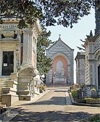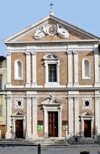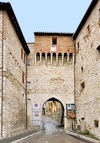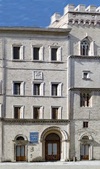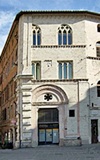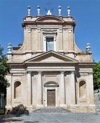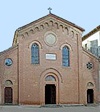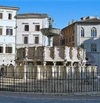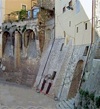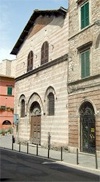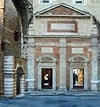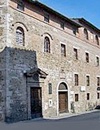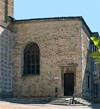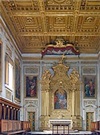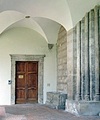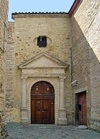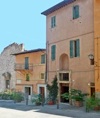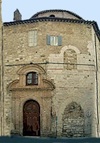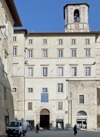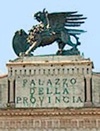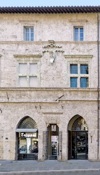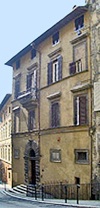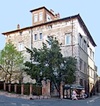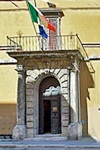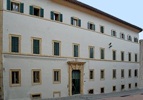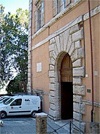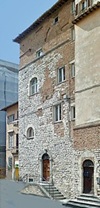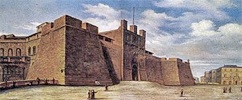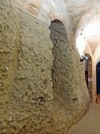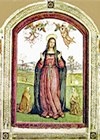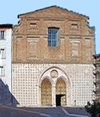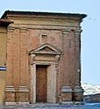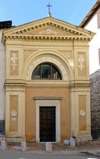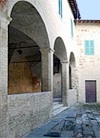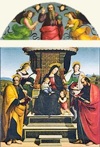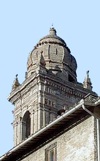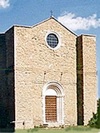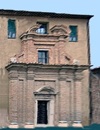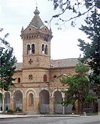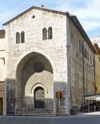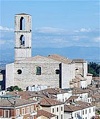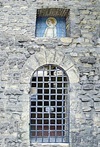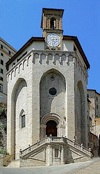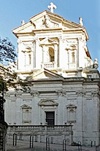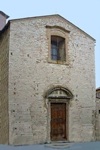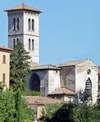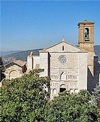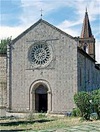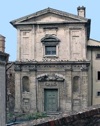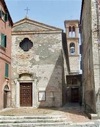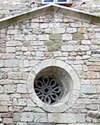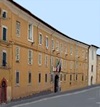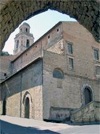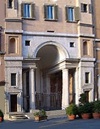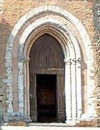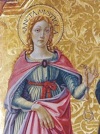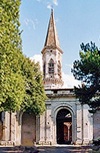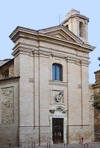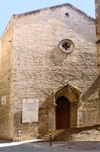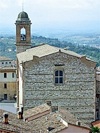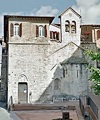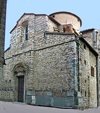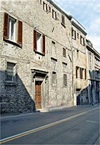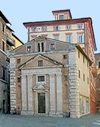Civic Cemetery (1849-86)
Bishop Gioacchino Pecci (the future Pope Leo XIII) established this cemetery in 1849 and Alessandro Arienti supervised its extension in the period 1874-86.
Chiesa del Gesù (1562-1622)
This church was built for the Jesuits soon after their arrival in Perugia. Its design is sometimes attributed to Giacomo Barozzi da Vignola. When the Jesuits were expelled in 1773, a community of Barnabites moved here from Sant’ Ercolano (below). The Barnabites still officiate at the church, but the adjacent ex-college is now part of the complex of the Tribunale di Perugia.
Chiesa della Morte (1575-1603)
This church, which is in the form of a Greek cross, was built for the newly-formed Compagnia della Buona Morte. Its design is attributed to Vincenzo Danti and Bino Sozi.
City Gates: in the Etruscan Walls
This page describes the remains of the known gates in the Etruscan walls of Perugia, which were probably built in the 4th century BC and rebuilt by the Romans in 295 BC. The main gates were later known as:
-
✴Arco Etrusco (Arco d' Augusto), illustrated here;
-
✴Porta Trasimena (Porta San Luca);
-
✴Arco della Mandorla (Porta Eburnea);
-
✴Porta Marzia;
-
✴Arco di Sant' Ercolano; and
-
✴Porta Sole, for which there are two candidates:
-
•the now-demolished Arco della Piaggia dei Calderari; and
-
•Arco dei Gigli.
City Gates: Other
Porta San Pietro (below) has its own page in this website. The other medieval gates described in this page are:
-
✴Walk III:
-
•Porta Santa Susanna (13th century), illustrated here;
-
•Arco di Via Appia (1257-77);
-
•Porta Vecchia della Conca (ca. 1300);
-
✴Walk IV:
-
•Porta dei Funari (13th century);
-
•Porta San Girolamo (1582);
-
•Porta di Braccio (13th century);
-
•Porta San Costanzo (1586-7);
-
•Porta dei Ghezzi (15th century);
-
•Tre Archi (1857);
-
✴Walk V:
-
•Porta Bulagaio (1764-5);
-
•Porta San Cristoforo (13th century, now demolished);
-
•Porta dello Sperandio (early 14th century);
-
•Porta Sant' Angelo (13th century);
-
✴Walk VI:
-
•Porta Santa Margherita (14th century);
-
•Porta del Carmine (13th century);
-
•Arco dei Tei (13th century)
-
•Porta Pesa (13th century, now demolished);
-
•Porta Sant’ Antonio (13th century);
-
✴Walk VII:
-
•Porta San Giacomo (13th century);
-
•Porta Eburnea Nuova (1576);
-
•Porta San Carlo (1612).
Collegio del Cambio (ca. 1452-7)
The Collegio del Cambio (guild of moneychangers) was the second most important guild of Perugia. Its headquarters in Palazzo dei Priori contains important frescoes (1496-1500) by Perugino.
Collegio della Mercanzia (1390)
The Collegio della Mercanzia (merchants' guild) is probably the oldest and was certainly the most important guild in Perugia. The presence of its headquarters in Palazzo dei Priori from an early date reflected its central role in the political life of the city.
Collegio dei Notai (1438-46)
The Collegio dei Notai (notaries’ guild) commissioned this palace following the demolition of its earlier premises near the Duomo. It was partially demolished in 1591, when what is now Via Guglielmo Calderini was built to the left of it. The guild moved to the room known as the Sala dei Notai in Palazzo dei Priori at this point, although it continued also to use the remaining part of the original palace until 1599. The ex-palace is now used as a shop.
Convento di Montemorcino Nuovo (1740)
Olivetan communities from Montemorcino (outside Perugia) and from Sant' Antonio Abate built this church and a huge monastery. The community was suppressed in 1809 and the complex was transferred to the University of Perugia in 1811.
Convento di Monteripido (1276)
This church and convent stand on the site of the hermitage on Monteripido in which the Blessed Giles lived for some 30 years and where he died in 1262. The Coppoli family gave the site to the friars of San Francesco al Prato in 1276. The church and convent that was subsequently built here passed to the Observant Franciscans in 1374. They were expelled 1865 but managed to return in 1874.
Duomo (San Lorenzo) (1435-81)
An earlier Duomo of Perugia seems to have been built here in the 10th century and apparently housed the relics of St Herculanus from 936. Its iconic campanile was at the heart of the civic life of Perugia until its destruction in in 1373-5. The old Duomo was subsequently incorporated into the current church as its transept. The relics of St Herculanus were translated to Sant’ Ercolano (below) in 1609. However, the Duomo still houses the Santo Anello (the Virgin's wedding ring), a relic that was translated to the Cappella di Sant' Anello in 1488.
Fontana Maggiore (1277-8)
This iconic fountain at the civic heart of Perugia is decorated by sculptures by Nicola and Giovanni Pisani.
Fontana Minore (1281; demolished 1308)
This fountain, which stood “in foro” (on the probable site of the Roman forum, in modern Corso Vannucci), is the earliest documented work by Arnolfo di Cambio. It ceased to function (possibly through an interruption in the water supply) in 1301 and was demolished in 1308. Some sculptural fragments, including the one illustrated here, survive in the Galleria Nazionale.
Fortezza di Porta Sole (1372-5)
The papal legate Gérard du Puy, Abbot of Marmoutier, (known to the Italians as “Monmaggiore”) commissioned this fortress to secure papal control of Perugia. It was mostly destroyed in 1375, when the Perugians revolted and expelled the legate from the city. This photograph shows the huge buttresses that supported the terrace on which the fortress was built, which survive in Piazza Piccinino.
Hospices and Hospitals and Other Charitable Organisations in Perugia
The Ospedale di Santa Maria della Misercordia is described in the page on its church (below). The smaller institutions described in this page are:
-
✴Walk IV:
-
•Conservatorio delle Derelitte (1704) and the Oratorio di Sant’ Anna;
-
•Ospedale di San Giacomo (1394);
-
•Sodalizio di San Martino (1574); and
-
•Ospedale dei Pellegrini (1333), illustrated here;
-
✴Walk V:
-
•Santa Maria Annunziata (14th century); and
-
•Sant' Egidio (1321);
-
✴Walk VI:
-
•San Crispino (1340); and
-
✴Walk VII:
-
•San Nicolò degli Incurabili (1585) and its church, San Giovanni di Dio (1584).
Maestà delle Volte (1567-90)
The church is named for a venerated fresco known as the Maestà delle Volte (1297). An oratory that was built in ca. 1335 to house the image was replaced by a larger chapel in 1440-75. This chapel was restored and extended after it was damaged in the rebellion of 1534. Bishop Fulvio della Corgna initiated further renovation when he transferred it to the Episcopal Seminary in 1566 and its facade was completed in 1584. The deconsecrated church is now a dress shop.
Nunneries of the Blessed Colomba
-
✴the nunnery that the Blessed Colomba established in what is now Corso Cavour in 1490, which was suppressed in 1864; and
-
✴the building (13th century) in what is now Corso Garibaldi (illustrated here) to which the nuns from the original nunnery and those from San Tommaso (below) moved in 1940.
Nunneries (Other)
The larger nunneries of Perugia have individual pages on this site. The others described on this page are:
-
✴Monastero delle Bartolelle (1604);
-
✴Santa Chiara (1552);
-
✴Santa Lucia (1472);
-
✴Santa Margherita (13th century);
-
✴Santa Maria della Colombata (ca. 1300), illustrated here;
-
✴Santa Maria Maddalena delle Convertite (1562);
-
✴Santa Maria delle Orfane (le Cappuccinelle) (1616);
-
✴San Paolo (1541);
-
✴San Paolo di Favarone (13th century); and
-
✴San Sperandio (1262).
Oratorio di Sant’ Agostino (16th century)
The oratory and adjacent hospice belonged to the Confraternita di Sant’ Agostino, which was formed in 1317. It became part of the Sodalizio Braccio Fortebraccio in 1904.
Oratorio dei SS Andrea e Bernardino (1537)
The oratory, which is behind the Oratorio di San Bernardino (below), was built for two lay confraternities that merged and moved here in 1537:
-
✴the Confraternita di Sant' Andrea della Giustizia, which had been formed in 1374 in Porta Santa Susanna ; and
-
✴the Confraternita di San Bernardino, which had been formed in 1456 in Porta Eburnea.
Oratorio di San Bernardino (1451-61)
This oratory was built next to San Francesco al Prato soon after the canonisation of St Bernardino of Siena. The decoration of its facade (1457-62) by Agostino di Duccio was one of the earliest works of the Renaissance in Perugia.
Oratorio di San Domenico (16th century)
This oratory off the cloister of San Domenico (below) belonged to the Confraternita di San Domenico, which was first documented in 1318. The confraternity became part of the Sodalizio Braccio Fortebraccio in 1904. The oratory now forms part of the Museo Archeologico.
Oratorio di San Francesco (mid 16th century)
The oratory belonged to the Confraternita di San Francesco, which was first documented in 1320. The confraternity became part of the Sodalizio Braccio Fortebraccio in 1904.
Oratorio dei SS Simone e Fiorenzo (16th century)
This oratory was established by two flagellant confraternities that merged in 1571:
-
✴the Confraternita di San Fiorenzo, which was established before 1337 near the church of San Fiorenzo (below); and
-
✴the Confraternita di San Simone, which was first documented in 1371 and associated with the nearby church of San Simone del Carmine (below).
Other Oratories in Perugia
The major oratories of Perugia have their own pages in this website (above). The smaller oratories described in this page are:
-
✴Walk III:
-
•Oratorio di Santa Cecilia (1687-90), illustrated here;
-
•Oratorio dei SS Girolamo, Francesco e Bernardino (1450), which was in the Convento di San Francesco al Prato;
-
✴Walk IV:
-
•Oratorio di San Pietro Apostolo (1579);
-
•Oratorio di San Pietro Martire (14th century);
-
✴Walk V:
-
•Oratorio di Santa Maria della Consolazione (1500);
-
✴Walk VI:
-
•Oratorio di Sant’ Antonio Abate (14th century);
-
•Oratorio di San Benedetto (1598);
-
•Oratorio di San Giovanni Battista (1636);
-
✴Walk VII:
-
•Oratorio dei SS Crispino e Crispiniano.
Palazzo dei Canonici (15th - 18th Centuries)
The original palace of the canons of San Lorenzo housed five papal conclaves in the 13th and early 14 centuries. The present palace houses the Museo Capitolare.
Palazzo del Capitano del Popolo (1472-81)
Gasparino d’ Antonio and Leone di Matteo designed this palace in Piazza del Sopramura (Piazza Matteotti). It now houses the Tribunale di Perugia (the Perugian law courts and associated offices).
Palazzo dei Priori (begun 1293)
This important civic palace was originally built to house the officials of the government of the popolani. It was extended on a number of occasions:
-
✴in 1303-40, for the new government of the Priori delle Arti;
-
✴in 1429-73, for purposes that included new premises for the Collegio del Cambio (above); and
-
✴after the Salt War (1540), to accommodate the papal governors.
It underwent a long and difficult restoration in 1862-1936 that restored it to something like its original appearance. The top two floors of the palace now house the Galleria Nazionale, while the rest of the building is still used by the municipal government.
Palazzo della Provincia (1869-72)
Alessandro Arienti designed this palace soon after Perugia was incorporated into the Kingdom of Italy. It was built on what had been the site of the central part of the hated Rocca Paolina (below).
Palazzo dell' Università Vecchia (1483-1515)
The Confraternita di Santa Maria della Misericordia commissioned Gasparino di Antonio to build this palace for use by the Studium of Perugia above a long arcade of shops that they owned in Piazza Sopramuro (Piazza Matteotti). Fiorenzo di Lorenzo is documented as having provided designs for the windows in 1490.
Palazzo del Podestà, Palazzo Vescovile and the Episcopal Seminary
This page describes Palazzo del Podestà, which was built in two phases: 1205-7; and 1282-92. It was largely rebuilt after a fire in 1329. Braccio Fortebracci occupied it during the time he was Lord of Perugia (1414-24) and it was later used by the papal governors of Perugia. It was burned down in 1534, in the rebellion that led to the Salt War. The page also describes two palaces that were built on the site in 1654-8:
-
✴Palazzo Vescovile (illustrated here); and
-
✴the Episcopal Seminary.
Palaces: Ansidei Family
-
✴Palazzo Ansidei di Catrano (15th-17th centuries) in Via Alessi, illustrated here;
-
✴Palazzo Ansidei di Montemarte (16th-18th centuries) in Piazza Ansidei;
-
✴Palazzo Manzoni Ansidei (1701) in Piazza Morlacci; and
-
✴Palazzo Ansidei (early 19th century) in Corso Vannucci.
Palaces: Baglioni and Oddi Families
-
✴Palazzo Baglioni (late 17th century);
-
✴Palazzo Balioddi degli Oddi (16th century); and
-
✴Palazzo Oddi Baglioni (17th century).
Palaces: Baldeschi Family
-
✴Palazzo Baldeschi Bonucci (1560-1626) in Piazza Cavallotti, illustrated here; and
-
✴Palazzo Baldeschi Cennini (14th-16th centuries) in Piazza della Repubblica.
Palazzo Bourbon di Sorbello (16th century)
Marquis Uguccione III Bourbon di Sorbello acquired this palace in 1780. It is now owned by the Fondazione Ranieri di Sorbello and houses an important “house museum” (see “Museums of Perugia”). It stands above the Pozzo Etrusco (below).
Palaces: Conestabile della Staffa Family
-
✴Palazzo Conestabile della Staffa (15th century) in Piazza Danti, illustrated here; and
-
✴Palazzo Conestabile della Staffa (1628-9) in Piazza Rossi Scotti (now the home of the Biblioteca Augusta).
Palaces: Donini Family
-
✴Palazzo Donini (1716-24), illustrated here; and
-
✴Palazzo Donini Nuovo (1780-6) behind it.
Palaces: Florenzi Family
-
✴Palazzo Florenzi (early 17th century) in Via Baglioni, the portal of which is illustrated here; and
-
✴Palazzo Danzetta Florenzi (17th century) in Largo Ermini.
Palazzo Gallenga Stuart (1748-58)
Giuseppe Antonori commissioned this palace, which was designed by the Roman architect Francesco Bianchi and executed by Pietro Carattoli. The palace received its current name in 1875, when the Piedmontese Romeo Gallenga bought it soon after his marriage to the English Mary Montgomery Stuart. It now houses the headquarters of the Università Italiana per Stranieri (University for Foreigners).
Palazzo Graziani (16th century)
Giovanni Battista Graziani commissioned the design of the present palace from Valentino Martinelli. (Local tradition attributes its design to Giacomo Barozzi da Vignola, although it was built some twelve years after his death). It now belongs to the Fondazione Cassa di Risparmio di Perugia.
Palazzo degli Oddi Marini-Clarelli (16th century)
This important “house museum” (see “Museums of Perugia”) is located in Palazzo degli Oddi Marini-Clarelli (16th century), which was the ancestral home of the degli Oddi family. It has recently been completely restored.
Palazzo della Penna (16th century)
Palazzo della Penna, which is an interesting palace to visit in its own right, also contain three important art exhibitions (see “Museums of Perugia”) and the remains of the Roman amphitheatre (see below).
Palaces: Rossi Scotti Family
-
✴Palazzo Rossi Scotti (17th century) in Piazza Rossi Scotti, the portal of which is illustrated here; and
-
✴Palazzo Rossi Scotti Mescolini (17th century) in Corso Cavour.
Palazzo Stocchi-Isidori (13th century)
This palace, which has been much modified over the centuries, is best known for the important frescoes (generally attribute to Cola di Petrucciolo and dated to ca. 1380) that were mostly detached from the walls and ceiling of a room on the first floor in 1894 and sold to the Szépművészeti Múzeum, Budapest.
Other Patrician Palaces
-
✴in Walk I:
-
•Palazzo Capocci (1361, illustrated here);
-
•Palazzo Ceccoli (17th century);
-
•Palazzo Danzetta (16th century); and
-
•Palazzo Lippi-Alessandri (17th century);
-
✴in Walk II:
-
•Palazzo Armellini (1524);
-
•Palazzo Bianchi (1873-6);
-
•Palazzo Brutti (17th century);
-
•Palazzo Crispolti (13th century); and
-
•Palazzo Veracchi (1550);
-
✴in Walk III:
-
•portal of Palazzo Pasini (17th century);
-
•Palazzo degli Sciri (13th century); and
-
•Palazzo Vermiglioli (17th century);
-
✴in Walk IV:
-
• Palazzo Baldeschi Colonna (17th century);
-
•Palazzo Cesarei Rossi Leoni (17th century);
-
•Palazzo Monaldi (1657); and
-
•Palazzo Pontani [date?];
-
✴in Walk VI:
-
•Palazzo Ranieri (17th century); and
-
•Casa di Ranaldus Ridolfinus (16th century);
-
✴in Walk VII:
-
•Palazzine Biscarini (1894);
-
•Palazzo Calderini (1871);
-
•Palazzo Ceccoli (17th century);
-
•Palazzo Cesaroni (1897);
-
•Palazzo Gnoni-Mavarelli (1860-2); and
-
•Palazzo Patrizi (early 18th century).
Porta San Pietro (14th-15th centuries)
This page describes:
-
✴the inner gate (14th century?), which was probably built on the site of an earlier gate (13th century) in an intermediate circuit of city walls ; and
-
✴the outer gate (15th century), by Agostino di Duccio and Polidoro di Stefano (illustrated here).
The Cappella di San Giacomo (ca. 1285, extended in 15 02), which stands between the inner and outer gates, is described under “Other Churches” below.
Pozzo Etrusco (3rd century BC)
This well under Palazzo Bourbon di Sorbello (above), which is fed by underground springs, was the main water tank of the Etruscan city. Excavations in 1965 revealed that the stone-clad cylinder is at least 37 meters deep.
Rocca Paolina (1540-7)
This fortress was built above the Etruscan walls of the city after the defeat of Perugia by Pope Paul III in the Salt War. The site was cleared by demolishing a number of important buildings, including a number of palaces that belonged to the Baglioni family. The fortress had a central core in what was later Piazza della Provincia and a southern stronghold linked to it by a fortified corridor. The hated fortress was demolished after the papal defeat of 1860, and Palazzo della Provincia (above) was built on the site. The excavated area under this palace, which contains the remains of the pre-1540 streets and buildings, is open to the public.
Roman Amphitheatre (1st century AD)
According to tradition, Totila's army set up its camp in the ruins of the Roman amphitheatre when it laid siege to Perugia in 549. Excavations in 1980 under Palazzo della Penna (above) unearthed remains of this amphitheatre and a nearby Roman road.
Sant' Agnese (14th century)
This site, which had belonged to community of Poor Clares from 1329, passed to a community of female Franciscan tertiaries in 1429. The sisters originally worked in their neighbourhood, but were forced to accept enclosure in ca. 1570. They survived periods of suppression in the 19th century and reverted to the rule of the Poor Clares in 1911. The precious fresco (1522) of the Madonna delle Grazie in their nunnery (part of which is illustrated here), which is attributed to the aged Perugino, can usually be visited.
Sant' Agostino (13th century)
The Augustinian Hermits established this church and convent before 1279. It was remodelled in the 14th century and largely rebuilt in 1799-1803. The Augustinian community was suppressed in in 1860. The church now serves the parish, while the convent houses the Caserma Militare Braccio Fortebracci.
Sant Andrea (12th century; rebuilt 19th century)
This church (Sancti Andree supra muros - Sant’ Andrea above the walls) was listed as a possession of the Benedictine Abbazia di Santa Maria di Farneta (near Cortona) in a privilege issued by the Emperor Henry II in 1014. It was reconstructed in the 19th century in neo-Romanesque style.
Sant' Angelo (6th century)
This church probably dates to the time of the Byzantine Duchy of Perugia, which was established in 536. The floor plan was originally that of a Greek cross. The central dome seems to have been rebuilt in brick in the 14th century, when three of the four chapels that formed the arms of the cross were demolished. The interior comprises two concentric circular spaces separated by a circle of sixteen columns came from even earlier (presumably pagan) buildings. The church was restored in 1948.
Sant’ Angelo della Pace (1548)
Cardinal Tiberio Crispo commissioned a loggia here that opened onto a magnificent panorama. Its design is traditionally attributed to Galeazzo Alessi. The arches of the loggia were subsequently closed to form the right wall of a church that was probably dedicated in honour of the “peace” that followed the Salt Wars. It passed to the Conestabile della Staffa family in the early 2oth century, and became the private chapel of the nearby Palazzo Conestabile della Staffa. The family gave both the palace and the ex-church to the Commune in 1969, in order to house the Biblioteca Augusta.
SS Annunziata (1814)
This is the third church to be built on the site of the ancient parish church of San Bartolomeo (documented in 1163):
-
✴This first church was demolished in 1615, when the parish was suppressed, and replaced by a church built by the Confraternita della Santissima Annunziata.
-
✴The nuns from the adjacent nunnery built the present church on their return here after the suppression of 1810. Their community was definitively suppressed in 1860.
The ex-nunnery subsequently passed to Conservatorio Musicale di Francesco Morlacchi, whose auditorium (sometimes open for concerts) is in the nuns' old refectory. The church, which is now de-consecrated, is occasionally open for lectures or concerts.
Sant' Antonio Abate (15th century, remodelled in 1654)
This church, which was first documented in 1163, seems to have been rebuilt after it passed to the hospitaller Canons Regular of St Antony of Vienne in the 15th century. A community of Olivetan monks moved here from the monastery of San Secondo on the Isola Polvese in 1624 and remodelled the church in 1654. They moved to the new monastery of Montemorcino Nuovo (below) in 1740. The old monastery was then adapted for residential use. The church is open to visitors on Sundays.
Sant' Antonio da Padova (ca. 1445)
A community of female Franciscan tertiaries built a church and nunnery here in ca. 1445. Although they resisted clausura for a number of decades, they were forced to accept it in 1572, at which point they probably became dependent on the nuns of Santa Maria di Monteluce. The nunnery closed in 1817, at which point the nuns moved to Santa Lucia (below). The complex was subsequently radically remodelled, first as an industrial complex and then for use as a residence for female students. The nuns had owned two priceless pieces of art:
-
✴the St Antony of Padua Polyptych (ca. 1468) by Piero della Francesca, which is now in the Galleria Nazionale; and
-
✴the so-called Colonna Altarpiece (ca. 1504) by Raphael, the main panel and lunette of which (illustrated here) are now in the Metropolitan Museum, New York.
San Benedetto dei Condotti (1421)
A community of Augustinian hermits from Montemalbe, outside Perugia built the first church and monastery here, which was known as Santa Maria Novella. The friars moved to Sant’ Agostino (above) in 1641. The complex then passed to a community of Sylvestrine nuns from San Benedetto (now Sant’ Erminio, below) and became known as San Benedetto dei Condotti: the second part of the name refers to the nearby aqueduct. This community was suppressed in 1820. The complex now belongs to the University of Perugia.
San Bevignate (1256-83)
This church and monastery, which belonged to the Knights Templar, was dedicated to the obscure Perugian cult figure “St” Bevignate. This became the most important Templar establishment in central Italy. When the Templars were suppressed in 1312, San Bevignate passed to the Knights of St John of Jerusalem, who established a nunnery here. The nuns were expelled in 1507 and, although the knights managed to regain possession of the complex in 1517-66, it subsequently passed to the Holy See. The complex was secularised in 1860 and the ex-nunnery is now in private ownership. Finds from the archeological excavation that was carried out under the pavement of the church during its recent restoration included part of the mosaic floor (1st century BC) of a Roman domus and a bronze Roman coin (ca. 200 BC). It is possible to arrange guided visits of the church and the excavated area.
Santa Caterina (1548)
Santa Caterina Vecchia was established outside Porta Sant’ Angelo before 1248. The sisters moved to Santa Caterina Nuova, inside the city walls, in 1649. They took over the church (illustrated here) and nunnery of San Bernardo, which Galeazzo Alessi had designed for the nuns of Santa Giuliana (below). The nunnery was suppressed in 1860 and part of it was demolished. The nuns subsequently returned, and the surviving buildings now house the only community of Benedictine nuns that survives in Perugia.
San Costanzo (11th century, rebuilt 1882-90)
This church, which was built on the burial site of St Constantius, was first documented here in 1027 as a dependency of the Abbazia di San Pietro (below). It was rebuilt and re-consecrated in 1205. The relics of St. Constantius were rediscovered under the high altar in 1781. The church was almost completely rebuilt in neo-Romanesque style in 1882-90 by Guglielmo Calderini.
Santa Croce (12th century)
This church was associated with an adjacent hospice that the Canons of the Holy Sepulcher established outside the Etruscan walls before 1120. The complex passed to the Order of the Hospital of St John of Jerusalem in 1489 and to the
Corporazione dei Falegnami (Carpenters’ Guild) in 1833. The hospice was largely demolished in 1857.
San Domenico (1305-1482)
The Dominicans, who arrived in Perugia in ca. 1234, built the present church on the site of the ancient Santo Stefano del Castellare. It was largely rebuilt after the vaults in the nave collapsed in 1614, although the original apse and apsidal chapels survive. The complex was suppressed and put to military use in 1860. Local demand prompted the recovery of the church in the early 1900s: it was finally restored in 1951 and the Dominicans were able to return in 1956. The larger part of the ex-convent now houses the Museo Archeologico Nazionale dell' Umbria.
Sant’ Elisabetta (1337)
This church was built for the last new parish to be created in Perugia in the Middle Ages, which served the the rapidly growing suburb of la Conca. It was largely was demolished to make way for the university buildings in 1903. A Roman mosaic (2nd century AD) that was unearthed in what had been the orchard of Sant’ Elisabetta can be visited.
Sant' Ercolano (1297-1326)
The Commune built this church on the presumed site of the martyrdom of St Herculanus, Perugia's patron saint. It belonged in succession to the Cistercians (1381-1444) and the Observant Servites (1444-ca. 1540). The upper part of what had been a double church was demolished in ca. 1540. Bishop Napoleone Comitoli restored the rest of the complex and transferred it to the Barnabites in 1607. He translated the relics of St Herculanus from the Duomo to Sant‘ Ercolano in 1609. The Barnabites left in 1774 and the complex passed to the Sodalizio di San Martino in 1777. The church re-opened recently after an extensive restoration following the earthquake of 1997.
Sant’ Erminio (ca. 1267)
The original Sylvestrine monastery here was used as a Sylvestrine nunnery from ca. 1293 until 1641. The site then passed to the Oddi family, who acquired the relics of St Erminius from Rome in 1662 and translated them to their church. The nuns from Santa Maria di Monteluce have owned the complex since 1927.
San Filippo Neri (1627-48)
The Oratarian Fathers, who were established in Perugia in 1614, soon moved to this site and built their imposing church. The first Mass was celebrated in the church in 1635, before the completion of its construction. It has recently been restored.
San Fiorenzo (1763-70)
This church and monastery belonged to the Camaldolesian Abbazia di San Salvatore di Monte Acuto from at least 1059. It passed to the Cistercians in 1234. They found the relics of St Florentius beneath the high altar in 1348, at the height of the Black Death. The complex passed to the the quasi-Cistercian Congregation of Corpus Christi in 1393 and to a group of Observant Servites from Santa Maria dei Servi in 1444. The convent was suppressed in 1863 and is now in secular use. The church, which was rebuilt in 1763-70, continued to serve the parish until relatively recently. It is now used by the Orthodox community of Perugia.
San Francesco delle Donne (early 13th century)
A group of Benedictine nuns from Sant’ Angelo di Arenaria (outside Porta Sant' Angelo) bought this site from the Franciscans when they moved to San Francesco del Prato (below) in 1253. The complex was restored in 1547. The nunnery was suppressed in 1815. It now houses co-operative dedicated to maintaining an old tradition of fabric production.
San Francesco al Prato (1253)
The Franciscans moved here from what became the nunnery of San Francesco delle Donne (above) ca. 1253. The Blessed Giles, one of the first companions of St Francis, was buried here in 1262, and the church was the centre of his cult. Unfortunately, it suffered from structural problems from its inception: it was restored in ca. 1421, but had to be essentially rebuilt in 1740-8. The Franciscans were expelled in ca. 1860. The abandoned church was restored and its facade was rebuilt early in the 20th century. The earthquake of 1997 destroyed almost everything except this facade: what survived has recently been restored. The ex-convent houses the recently re-opened Museo dell’ Accademia di Belle Arti.
San Girolamo (1485-90)
This church and convent belonged to the Amadeiti Fathers, a reformed branch of the Franciscan Order. The friars, who were absorbed by the Observant Franciscans in 1568, remained here until 1866. The ex-church now houses a cinema.
Santa Giuliana (mid-13th century)
This nunnery belonged to the Cistercian Order from its foundation until 1567, when it was placed under episcopal control. Its church retains it Gothic features, despite its remodelling in 1595 and again in 1750. The nuns were expelled in 1862 and the ex-nunnery passed to the military. The church was re-opened in 1937. The ex-nunnery can sometimes be visited.
San Luca (1586)
The Canons of the Holy Sepulcher established a church and hospice here in 1184. The church and adjacent Casa della Commenda became the headquarters of the Order in 1291. The complex passed to the Order of the Hospital of St John of Jerusalem in 1489. The church was largely rebuilt in the 16th century. The complex now houses the Gallerie dei Gerosolimitani and is used for cultural exhibitions.
San Manno (13th century)
This site belonged to the Templars until their suppression in 1307, when it became the residence of the Master of the Canons of the Holy Sepulchre, whose main priory was at San Luca (above). It passed to the Hospitallers of St John of Jerusalem (Knights of Malta) in 1356 and remains in their ownership. The crypt of the church was adapted from an Etruscan hypogeum that is now known as the Ipogeo di San Manno.
Santa Maria degli Angeli (1468-1505, remodelled in 1852-5)
The Poor Clares who were first documented here in 1279 moved to Santa Maria di Monteluce (below) in 1464. The complex passed to the Augustinian Canons of San Salvatore, Venice in 1468. They rebuilt the monastery and built a new church. This community was suppressed in 1789. The complex was used as an orphanage and then, after 1857, as a college for the daughters of noble families known as the Collegio di Sant’ Anna. The church was deconsecrated in the 1970s and the complex now houses two schools and a cultural institute.
Santa Maria di Colle (14th century)
An ancient oratory dedicated to the Virgin on this site became a parish church in 1366. The church was extensively remodelled in 1717, possibly in response to a miracle associated with a venerated image of the Madonna that was then housed here. Another venerated image of the Madonna and Child from a nearby house, which was translated to the church in 1796 after it performed a series of miracles, is still here. The parish was suppressed in 1833. The church, which is known as the Auditorium Marianum, is sometimes open for concerts.
Santa Maria dei Francolini (12th century)
The church probably belonged originally to the ancient Francolini family. It was first documented in 1166, when it was transferred from Abbazia di San Salvatore di Valdicastro to the canons of the Duomo of Gubbio. It was recorded as a parish church by 1285 and appeared as a possession of San Luca (above) in 1482. The parish was suppressed in 1771. The church was transferred to the Compagnia dei Servatori di Santa Anna in 1779, when the upper of the church was rebuilt. It is open to the public only on the feast of St Anne (26th July). It also hosts meetings of the Confraternita di San Jacopo di Compostela.
Santa Maria della Luce (1513-9)
In 1512, the Knights of St John donated this site next to their church of San Luca (above) to the Commune for this church, which was to be built to house a highly venerated image of the Virgin. It is usually open for prayer.
Santa Maria Maddalena delle Repentute (14th century)
The Commune established a nunnery here in 1345, to house women who repented of their worldly way of life. It was subordinated to the nunnery of Santa Caterina (above) in 1382. The nuns were removed from episcopal control and placed under the protection of the monks of San Pietro (below) in 1487. The link with Santa Caterina was broken in 1590 and that with San Pietro in 1703, when Santa Maria Maddalena returned to episcopal control. The complex was completely restructured in the 18th century. The nunnery was suppressed in 1864, when its nuns moved to Santa Caterina. Their old complex now houses the Umbrian headquarters of the Carabiniari, and is closed to the public.
Santa Maria della Misericordia (1303, rebuilt 1760)
This complex belonged to the Confraternita di Santa Maria della Misericordia, which was formed in ca. 1300 and reconstituted in 1396. Charitable donations enabled the confraternity to invest in property in the vicinity. The church of Santa Maria della Misericordia took over the role of two nearby parish churches: SS Donato e Arrigo, in 1402; and Santa Lucia di Colle Landone, in ca. 1540. The hospital survived until 1923, when it was incorporated into the modern hospital that was built in the ex-nunnery of Santa Maria di Monteluce (below). The church was de-consecrated at that point. It has recently been restored and now houses an art gallery.
Santa Maria di Monteluce (13th century, restored in 1451)
A nunnery here was one of the first to follow the rule for “poor cloistered ladies” that Cardinal Ugolino established in 1219. As Pope Gregory IX, Cardinal Ugolino granted the nuns a “privilege of poverty” in 1229. In 1247, Pope Innocent IV established the Franciscan character of the developing order, which subsequently became known as the Order of St Clare. He consecrated the nuns’ new church in 1253. A group of nuns from Santa Lucia, Foligno reformed the nunnery in 1448 and it was placed under the guidance of the Convento di Monteripido (above). These changes led to its period of greatest splendour. It began its decline in 1703, when it was placed under episcopal jurisdiction. It nevertheless survived until 1927, when the nunnery was commandeered for the hospital and the nuns moved to Sant' Erminio (above). The hospital here closed in 2008 and is now the subject of ambitious development plans. The church remains in use.
Santa Maria Nuova (1568)
The parish church of Santa Maria di Porta Sole was documented here in 1285. A community of Sylvestrine monks moved here from San Benedetto (now Sant' Erminio, above)in 1293. Fire destroyed much of the complex during the riots attending the destruction of the Fortezza di Porta Sole (above) in 1376, at which point the Sylvestrines moved to San Fortunato (see “Other Churches” below). Some of them returned to what was left of their monastery in 1404 and rebuilt the church (Santa Maria Nuova) on the site of the present apse and transept. The complex passed to the Servites from Santa Maria dei Servi (below) in ca. 1540, at which point its Sylvestrines re-joined their colleagues at San Fortunato. The Servites rebuilt the church on a larger scale. They left Perugia in 1998. The convent has been adapted as apartments, but the church is still occasionally open for services.
Santa Maria del Popolo (ca. 1547)
This was the site of the parish church of Santa Maria del Mercato (13th century), which was used by a number of the city guilds and which was the place in which the guilds’ representatives to the governing Priori took their oaths of office. The building of Via Nuova necessitated the demolition of this important church, so Cardinal Tiberio Crispo commissioned Galeazzo Alessi to build the present church as a replacement. It was consecrated in 1548. The parish was suppressed in 1760 and the church was deconsecrated in 1866. The portico (ca. 1547) by Galeazzo Alessi survives, albeit much altered and overshadowed by the upper stories of the adjacent Palazzo Danzetta (see “Other Patrician Palaces” above), which were built above it in the 18th century.
Santa Maria dei Servi (1430: demolished)
In 1313, the Servites moved to this site on Colle Landone with the support of the noble families (principally the Baglioni) who lived nearby. They extended their church here in 1430. Following the destruction of this church in ca. 1540 to make way for the moat of Rocca Paolina (above), the Servites moved to Santa Maria Nuova (above). In ca. 1547, Cardinal Tiberio Crispo reused the Gothic portal from the demolished church (illustrated here) during his restoration of Sant’ Angelo (above).
San Matteo degli Armeni (before 1273)
A community of Armenian monks acquired an ancient church on this site from the canons of the Duomo in 1273 and built an adjacent monastery and scriptorium. The monks left the complex in 1523, after which it was used as a hospice for lepers. Jacopo Oddi used it as a private residence from 1632. The complex has recently been restored. The church, which contains important frescoes, is used by the Orthodox community of Perugia and is open for services on Sundays. The ex-monastery houses part of the collection of the Biblioteca Augusta.
Santa Mustiola (13th century: demolished)
This church, which was dedicated to the patron saint of Chiusi, originally belonged to a community of Augustinian canons and seems to have been dependent upon the canonical church of Santa Mustiola, Chiusi. It seems to have been abandoned by 1454, when it passed to the Confraternita di Sant' Andrea della Giustizia. The confraternity moved to the Oratorio dei SS Andrea e Bernardino (above) in 1537, and the church was demolished shortly thereafter. A community of Capuchin nuns built the church and nunnery of Santa Chiara (see “Other Nunneries” above) on the (probable) site in 1552.
San Pietro (12th century)
A church on this site dedicated to St Peter was recorded in the Dialogues (593) of Pope Gregory I as the burial place of St Herculanus. St Peter Abbot is reputed to have formed a Benedictine monastery here in ca. 965. The monastery secured exemption from episcopal control early in its history, and subsequently enjoyed the support of successive popes and emperors. The complex was transferred to the Cassinese congregation in 1436. The complex was extensively renovated in 1506-1630. The monks sided with the city in the anti-papal rebellion of 1859 and were rewarded by exemption from the religious suppressions that followed. However, the monastery was closed and transferred to the
Fondazione per l' Istruzione Agraria in 1897. The church is still in use and, like the abbey grounds, is open to visitors.
San Prospero (11th or 12th century)
This church was built on the site of an Etrusco-Roman burial ground. It was probably built in the 7th or 8th century, and rebuilt and extended to the left in the 11th or 12th century. It was documented as a parish church in 1285. The parish was abolished in 1567, and the church passed to the Collegio del Seminario. The upper storey was probably added at about this time. It was in secular use by 1786 and was bought by its current owners, the Istituto Don Bosco, in 1935. It preserves a number of important works of art, including
-
✴its early Christian ciborium; and
-
✴frescoes (1225) that were signed by Bonamicus, the first Perugian painter for whom we have a name.
SS Sebastiano e Rocco (early 15th century)
The Confraternita di San Sebastiano e Rocco was given a small oratory on this site that housed a miraculous image of the Madonna in 1484. They subsequently built the present church here. It became a parish church when the nearby church of Sant’ Elisabetta (above) was demolished in 1903.
San Severo (1748-51)
This seems to have been the site of a Camaldolesian monastery from 1007. Its church was rebuilt in the 15th century and again in 1748-51. The precious fresco (1505-21) by Raphael and Perugino survived destruction and is now in an adjacent building that can be visited. The monastery of San Severo was closed in 1935. The church is used by the Knights of the Order of the Holy Sepulcher of Jerusalem.
SS Severo e Agata (1317)
A church dedicated to St Agatha was documented here in 1163. The Commune rebuilt and re-dedicated it when the old church of San Severo was demolished to make way for an extension of Palazzo dei Priori (above). A number of interesting frescoes (14th century) survive inside. The church was closed for restoration during my last visit (January 2013).
San Simone del Carmine (1377)
The parish church of SS Simone e Guida was documented here in 1285. It passed to a community of Carmelites in 1296, who re-dedicated it to St Simon Stock. They built the adjacent convent. They rebuilt the church in 1377. Although the church was remodelled on a number of occasions, much of the original exterior survives. The Carmelites were expelled in 1860: the convent re-opened in 1861 as the first kindergarten in Umbria; the church [which now belongs to the Knights of the Holy Sepulcher of Jerusalem] is usually closed.
Santo Spirito (1675-1689)
This was the site of a monastery from at least 1014 and then a nunnery from at least 1239 until 1428. The Minims of San Francesco di Paola acquired the abandoned complex in 1576. Construction was protracted, and the church was not consecrated until 1736, The convent was suppressed in 1860, and the church is now serves the parish.
SS Stefano e Valentino (12th century)
This ancient church was extended in the 14th century. It preserves some interesting frescoes inside.
Santa Teresa degli Scalzi (1626-1718)
The reformed Carmelite congregation built this church and convent. The community was suppressed in 1870, and the complex is now used as a school.
San Tommaso (13th century)
A Cistercian nunnery existed here from at least 1274. The community was reformed and transferred to the Dominican rule in 1555. The community was suppressed in 1864. However, a few nuns managed to remain here until 1940, when they moved to the Monastero della Beata Colomba (above). The complex now houses a school and and a museum (Perugia Officina per la Scienza e la Tecnologia).
Monastero della Santissima Trinità (1210)
This was the site of a Camaldolesian monastery from 1209 until 1484, when the monks moved to San Severo (above). The church was partially demolished in 1793, although its apse survives in the form of a small chapel that is in private ownership.
Other Churches
-
✴in Walk I:
-
•Sant’ Isidoro (16th century), illustrated here;
-
✴in Walk II:
-
•Sant' Andrea (1721);
-
•San Benedetto Vecchio (11th century);
-
•San Donato (1776);
-
•San Giovanni del Fosso (11th century);
-
•San Giuseppe (12th century);
-
•Santa Lucia delle Volte (1547);
-
•Santa Maria degli Aratri (10th century, demolished 1874);
-
•Santa Maria della Valle (11th or 12th century);
-
•San Martino del Verzaro (11th century);
-
✴in Walk III:
-
•Sant’ Antonino (12th century);
-
•Santa Croce (12th century);
-
•San Giovanni Battista (1607);
-
•San Gregorio (11th century, now demolished);
-
•San Matteo in Campo d' Orto (12th century);
-
✴in Walk IV:
-
•San Claudio (1476, destroyed in 1798);
-
•Cappella di San Giacomo (ca. 1285, extended in 1502);
-
•Santa Lucia di Colle Landone (16th century);
-
•Santa Maria di Braccio (1476-9);
-
✴in Walk V:
-
• San Cristoforo (13th century);
-
•San Fortunato (12th century);
-
•Cappella della Madonna della Stella (14th century);
-
•Santa Maria Consolatrice degli Afflitti (1748);
-
✴in Walk VI:
-
•Santa Maria delle Grazie di Monterone (1534);
-
•Santa Maria della Pace (1571-3, now demolished);
-
•Santa Maria Maddalena (1285);
-
✴in Walk VII:
-
•Sant’ Angelo in Porta Eburnea (11th century);
-
•San Giacomo (13th century);
-
•Santa Maria del Riscatto (1657);
-
•San Nicolò, later San Giorgio dei Tessitori (demolished);
-
•SS Savino e Cataldo (16th century);
-
•SS Stefano e Biagio (12th century);
-
•Chiesa del Suffragio (1639)
Sapienze (Colleges)
-
✴Sapienza Vecchia (1362), illustrated here; and
-
✴Sapienza Nuova (1427: demolished 1540);
-
✴Sapienza Bartolina (1571); and
-
✴Sapienza Oradina (1572).
Theatres
-
✴Teatro del Pavone (1765-73), illustrated here;
-
✴Teatro Morlacchi (1780; remodelled in 1870-4); and
-
✴Teatro Turreno (1891).




